Penrhyn Castle
| Castell Penrhyn | |
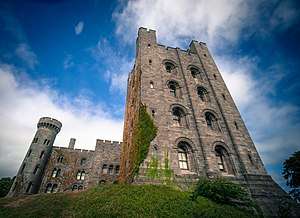 The donjon or keep (right) and a side view of the central block (left) | |
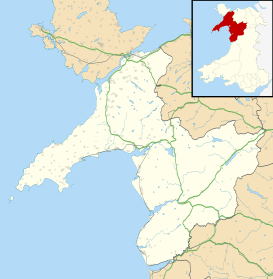 Location within Gwynedd | |
| Established | 1951 |
|---|---|
| Location | Llandygai, Gwynedd, Wales |
| Coordinates | 53°13′34″N 4°05′41″W / 53.226003°N 4.094681°W |
| Type | Historic house |
| Owner | National Trust |
| Website | Penrhyn Castle |
Penrhyn Castle is a country house in Llandygai, Bangor, Gwynedd, North Wales, in the form of a Norman castle. It was originally a medieval fortified manor house, founded by Ednyfed Fychan. In 1438, Ioan ap Gruffudd was granted a licence to crenellate and he founded the stone castle and added a tower house. Samuel Wyatt reconstructed the property in the 1780s.
History
The present building was created between about 1822 and 1837 to designs by Thomas Hopper,[1] who expanded and transformed the building beyond recognition. However a spiral staircase from the original property can still be seen, and a vaulted basement and other masonry were incorporated into the new structure. Hopper's client was George Hay Dawkins-Pennant, who had inherited the Penrhyn estate on the death of his second cousin, Richard Pennant, who had made his fortune from slavery in Jamaica[2] and local slate quarries. The eldest of George's two daughters, Juliana, married Grenadier Guard, Edward Gordon Douglas, who, on inheriting the estate on George's death in 1845, adopted the hyphenated surname of Douglas-Pennant. The cost of the construction of this vast 'castle' is disputed, and very difficult to work out accurately, as much of the timber came from the family's own forestry, and much of the labour was acquired from within their own workforce at the slate quarry. It cost the Pennant family an estimated £150,000. This is the current equivalent to about £49,500,000.
Penrhyn is one of the most admired of the numerous mock castles built in the United Kingdom in the 19th century; Christopher Hussey called it, "the outstanding instance of Norman revival." [3] The castle is a picturesque composition that stretches over 600 feet from a tall donjon containing family rooms, through the main block built around the earlier house, to the service wing and the stables.
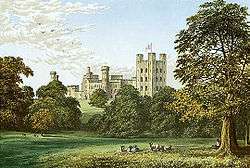
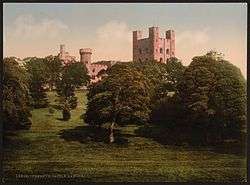
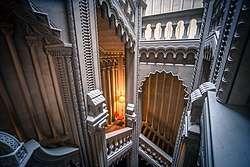
It is built in a sombre style which allows it to possess something of the medieval fortress air despite the ground-level drawing room windows. Hopper designed all the principal interiors in a rich but restrained Norman style, with much fine plasterwork and wood and stone carving. The castle also has some specially designed Norman-style furniture, including a one-ton slate bed made for Queen Victoria when she visited in 1859.
Hugh Napier Douglas-Pennant, 4th Lord Penrhyn, died in 1949, and the castle and estate passed to his niece, Lady Janet Pelham, who, on inheritance, adopted the surname of Douglas-Pennant. In 1951, the castle and 40,000 acres (160 km²) of land were accepted by the treasury in lieu of death duties from Lady Janet. It now belongs to the National Trust and is open to the public. The site received 109,395 visitors in 2017.[4]
Attractions
Gardens
Penrhyn's attractions include a formal walled garden, extensive informal gardens, an adventure playground, picnic areas and woodland walks.
Railway Museum
The Penrhyn Castle Railway Museum, a narrow gauge railway museum. In the nineteenth century, Penrhyn Castle was the home of the Pennant family (from 1840, the Douglas-Pennants), owners of the Penrhyn slate quarry at Bethesda. The quarry was closely associated with the development of industrial narrow-gauge railways, and in particular the Penrhyn Quarry Railway (PQR), one of the earliest industrial railways in the world. The PQR ran close to Penrhyn Castle, and when the castle was bequeathed to the National Trust in 1951 a small museum of industrial railway relics was created in the stable block. The first locomotive donated to the museum was Charles, one of the three remaining steam locomotives working on the PQR. Over the years a number of other historically significant British narrow-gauge locomotives and other artifacts have been added to the collection.
Art collection
It houses one of the finest art collections in Wales, with works by artists such as Canaletto, Richard Wilson, Carl Haag, Perino del Vaga, and Palma Vecchio. The collection formerly included a Rembrandt - (Catrina Hooghsaet, valued at up to £40 million; the Dutch Culture Ministry tried to buy the painting for Amsterdam’s Rijksmuseum in 2007, but could not meet the asking price). The family began collecting paintings from the early years of the 19th century; this significant collection was catalogued by the 2nd Lord Penrhyn's daughter Alice Douglas-Pennant.
Countryside views
The castle has stunning[5] views over the Snowdonia mountains, the Menai Strait and Puffin Island.
References in popular culture
In 2014, David Haneke from the Welsh National Opera chose Penrhyn Castle as the location for the video design for the company's summer performance of Debussy's infamous The Fall of The House of Usher. Scenes filmed at the location were projected onto three separate screens during the performances.
Events
A parkrun takes place in the grounds of the castle each Saturday morning, starting and finishing at the castle gates, the fee to enter the castle grounds is waived for runners.[6]
See also
References
- ↑ Port, M. H. (2004). "Hopper, Thomas (1776–1856)". Oxford Dictionary of National Biography. Oxford University Press. doi:10.1093/ref:odnb/13763. Retrieved 2013-01-23. (subscription or UK public library membership required)
- ↑ "George Hay Dawkins Pennant Profile & Legacies Summary". Legacies of British Slave-ownership UCL. UCL. Retrieved 14 October 2017.
- ↑ English Country Houses: Late Georgian (1988 edition), p. 181. ISBN 1-85149-032-9.
- ↑ "ALVA - Association of Leading Visitor Attractions". www.alva.org.uk. Retrieved 17 May 2018.
- ↑ https://www.walesonline.co.uk/special-features/visit-one-wales-most-impressive-7023723
- ↑ http://www.parkrun.org.uk/penrhyn/course/
External links
| Wikimedia Commons has media related to Penrhyn Castle. |